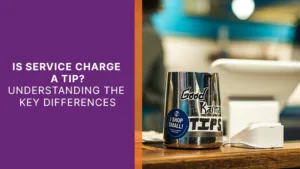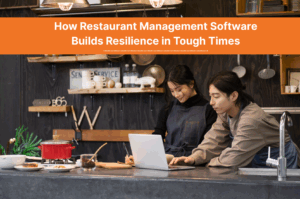The hospitality industry moves at a breakneck pace.
In restaurants, where chaos often meets creativity, clear communication is key to creating a seamless dining experience. Whether you’re dining out, managing a bustling establishment, or aspiring to join the culinary world, understanding the unique language of restaurants can be a game-changer.
In restaurants’ bustling and often chaotic environments, communication is key to a seamless dining experience.
Understanding the unique language of the culinary world not only enhances your appreciation of food but also allows for smoother interactions with restaurant staff.
From back-of-the-house operations to front-of-the-house service, restaurant lingo encompasses a variety of terms and phrases that are essential to the industry. Understanding these terms equips you to interact confidently with staff.
This article will guide you through some must-know restaurant terms, exploring their meanings and implications in both casual conversations and professional settings. With this knowledge, you’ll be better equipped to confidently navigate the culinary world.
Restaurant Slang
Restaurant lingo is more than just colorful phrases; it’s a critical part of the industry’s workflow. For new employees, learning these terms helps them integrate quickly and avoid errors, especially during busy service hours. For seasoned staff, slang strengthens camaraderie and keeps operations running smoothly.
In fast-paced environments like Quick Service Restaurants (QSRs) and full-service establishments, clear communication can make or break a shift. Terms like “ticket” (a POS system printout of orders) or “expo” (the person organizing dishes for service) ensure teams stay on the same page, improving efficiency and customer satisfaction.
These terms help create a cohesive work environment where everyone stays on the same page, improving overall efficiency and customer interactions.
Some Common Slang, Terms and Phrases
Understanding restaurant slang is crucial for effective communication among staff and smooth operations—terms like “deuce” for a table set for two guests or “campers” referring to customers who linger at their tables offer industry insight. Familiarity with this jargon is essential for both kitchen and service staff.
The restaurant business has lots of unique terms, and this list is by no means exhaustive, here are a few that you will probably hear often.
Here’s a curated list of commonly used terms to help you navigate the culinary world:
Back of the House
The back of house (BOH) includes areas like the kitchen and dishwashing space, which are crucial for food preparation and cleaning.
Staff roles here include chefs, the executive chef or head chef, line cooks, and dishwashers, all essential for maintaining food quality. Systems like the brigade help establish clear responsibilities among kitchen personnel.
Front of the House
The front of house (FOH) encompasses customer-visible areas like the dining room and bar.
Roles here include servers, hostesses, and bartenders, who ensure a smooth dining experience. The maitre d’ plays a crucial role in overseeing guest interactions and maintaining a welcoming atmosphere.
86’d
“86’d” signals a menu item is unavailable due to ingredient shortages or quality issues.
It also applies to customers or staff being removed for various reasons. Both kitchen staff and servers need to understand this term to manage menu availability effectively.
2-top, 4-top
“2-top” and “4-top” refer to tables set for specific numbers of guests.
Hosts use these terms to communicate seating arrangements efficiently. Understanding these designations helps manage table assignments, contributing to organized dining service.
À la carte
The term à la carte is a French term for individually priced menu items.
Customers ordering à la carte need to select sides separately. To inform guests during their order, servers need to know which dishes are à la carte.
In the Weeds
“In the weeds” describes staff being overwhelmed with orders or service demands.
It applies to both kitchen and front-of-house staff facing peak business pressures. The term emphasizes efficient workload management during busy periods.
As an owner or manager, keep your ears open for this one! A slowdown of table service over an extended period is something to be avoided.
In the Window
“In the window” refers to the spot where completed dishes await pickup by servers.
Positioned between the kitchen and server station, it ensures food stays warm with heat lamps. This setup is vital for maintaining food quality before serving.
Dead Plate
A “dead plate” is an unsellable individual dish due to errors or customer complaints.
It often results from issues like poor appearance or delays. Policies on how to handle dead plates vary, but they often can’t be served to guests.
Upselling
Upselling involves encouraging guests to choose more expensive items or add-ons to increase sales.
Effective upselling enhances the guest experience while boosting profits. It requires product knowledge and subtlety to benefit the restaurant’s financial success.
Host
The host greets guests and manages seating arrangements, setting the dining experience’s tone.
They coordinate the dining room flow and address guest concerns. Good hosting ensures efficient service and high customer satisfaction.
Signature Dish
A recipe that identifies a particular chef or restaurant.
Some universal food items can be found anywhere and then some are unique to one restaurant or even a chef. Not all restaurants have these, especially if they’re part of a franchise.
Restaurant Management Software
Restaurant management software (RMS) integrates tools like point of sale (POS) systems to streamline operations.
CRM software enhances customer service by tracking preferences, while kitchen display systems aid order management. These technologies ensure efficient operations and improved guest experiences.
Speaking of Restaurant Management Software…
In the fast-paced restaurant world, communication is as essential as the food itself.
Effective RMS tools streamline operations, from tracking inventory to managing reservations and improving coordination between kitchen and service staff.
SynergySuite’s award-winning software is designed to help restaurant enterprises of all types—QSRs, franchises, and full-service establishments—reduce errors, boost efficiency, and elevate the guest experience.
By integrating tools like POS systems, labor, scheduling, and reporting, SynergySuite empowers restaurant teams to focus on what they do best: delivering outstanding service.
Ready to transform your operations?
Get in touch with us today to schedule a free, personalized demo to see how SynergySuite can help your restaurant thrive.






